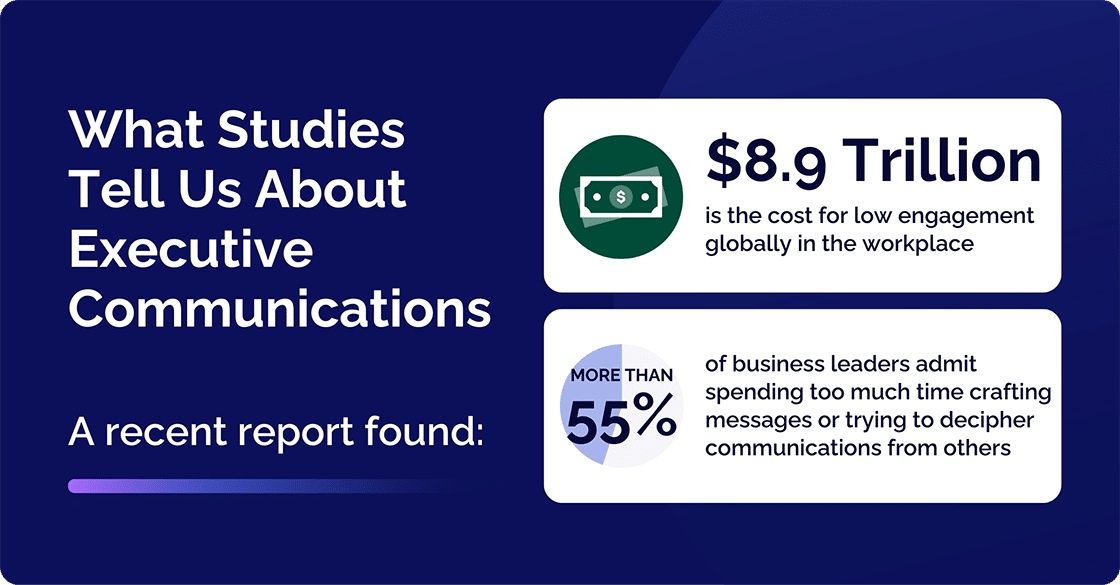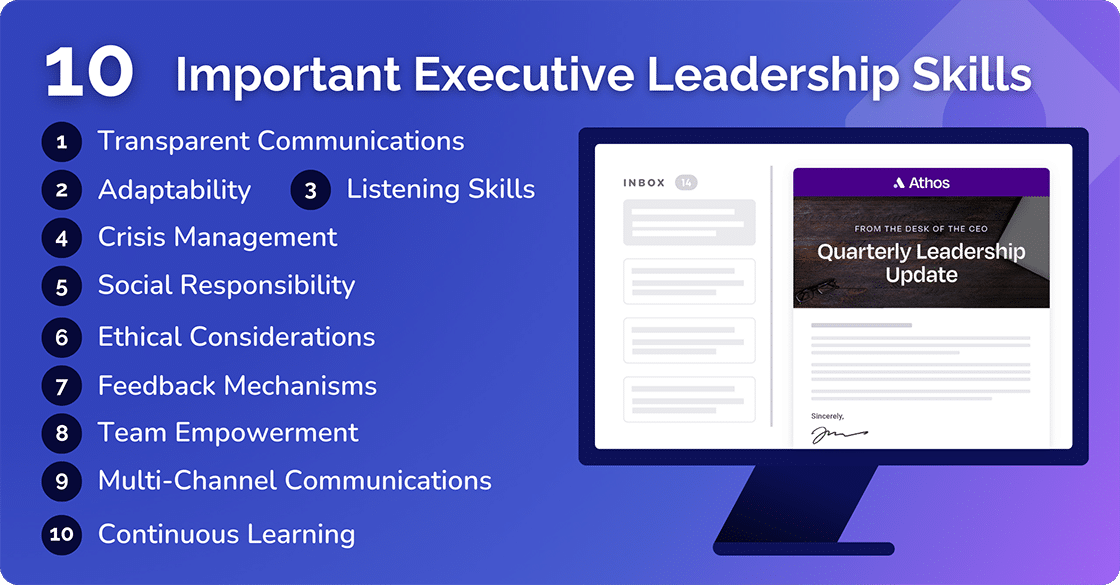Enhance your impact with executive communications. Expert advice to lead, inspire, and communicate effectively with key stakeholders.

.webp)
Effective internal communication is the backbone of every successful organization. Learn the ins and outs of internal communications with our research-backed white paper.
Access NowThere’s no doubt that effective executive communications are crucial for modern leadership. When well structured, they play a pivotal role in shaping the culture of an organization. They also help drive successful strategies and foster stakeholder engagement. However, CEOs and other business leaders should clarify their expectations to employees. Sometimes leaders don’t define their vision of success and communicate it adequately. This lack of clarity is likely to produce meaningless cultures that impact them negatively, as we show later on in this post.

It stands to reason that an executive communications plan will be part of a company’s overall internal communications strategy. Executive communications play a pivotal role in a company’s internal communications plan. They provide leadership with a platform to articulate organizational goals, foster transparency, and align employees with the company’s vision. Done correctly and convincingly, executive communications will effectively convey strategic messages from executives helping to build a cohesive corporate culture. They will also ensure there is a shared understanding of the company’s mission and goals among employees at all levels.
In her book, Nobody Believes You: Become a Leader People Will Follow, internal communication and leadership credibility expert, Jenni Field, tackles universal credibility problems that leaders face. She examines why it’s so important to be credible rather than authentic. Why people (think employees) don’t buy into what you want them to do — and why employee engagement scores aren’t improving.
“When nobody believes you, almost everything feels like a wrestling match. When everybody believes you, almost anything becomes possible.”
Jenni Field
Jenni has helped leaders and teams tackle internal communication issues for the past two decades. She shares that leaders often believe that communication isn't working and teams simply don’t listen. However, the truth is that the root of these problems often lies with leadership. We agree!
On the surface, communication in any workplace simply involves an exchange of ideas and thoughts. But that’s not enough to make it meaningful.
When it comes to executive communications, no-nonsense executive coach and Forbes Councils Member, Jennine Heller believes that less is more. In a March 2025 Forbes post, Less Is More: Successful Communication At The Executive Level,
“As you adapt to executive-level communication, you’ll find that even a few moments of preparation — thinking about your audience and crafting a concise, clear message — will yield shorter but more effective interactions. And delivering the right level of information shows your seniority more than covering every detail to prove that you know your stuff. Your direct reports, colleagues and leadership will appreciate knowing exactly what your message is, why it matters, and how they can contribute.”
Jennine Heller
Without clarity, employees are less likely to be motivated and their actions may not align with the strategic goals of the organization. There may also be reduced uncertainty among employees because of a lack of clear leadership. This often leads to decreased job satisfaction and increased quitting.
Additionally, communication can be more of a challenge when it involves people with different backgrounds and points of view. Unfortunately, in work environments, this often leads to conflict. It’s up to leaders to ensure that executive and CEO communications are effective and efficient. Also, it needs to work both ways, so that employees also have their say. And it needs to achieve goals to make it worthwhile.
How effective is your internal communications strategy? Research on communication effectiveness highlights key touchpoints that are relevant across all types of communication — including all-important internal executive communications.
According to Grammarly’s The 2024 State of Business Communication Report: What You Need to Know, ineffective communication in the workplace costs U.S. businesses $1.2 trillion every year. The report states that about one in five business leaders admit they have lost business due to poor communication. However, on the bright side, twice as many (43%) say they have gained new business because of effective communication.
Miscommunication remains a huge problem, impacting everything from costs to morale. More than (55%) of business leaders admit spending too much time crafting messages or trying to decipher communications from others. Nearly as many (54%) find it challenging to manage the volumes of work communications, and 53% are constantly anxious they might misinterpret written messages.
Conversely, effective communication helps businesses prompt strong employee experiences and customer satisfaction. Virtually all professionals have experienced benefits from improved communication, with knowledge workers citing increased job satisfaction (58%) and improved team relationships (also 58%).”
2024 Grammarly Report
In its State of the Global Workplace 2024 Report: The Voice of the World’s Employees, Gallup puts the cost for low engagement globally at U.S. $8.9 trillion — $100 billion up from 2023 when it was $8.8 trillion.

Amongst other things, the report examines the role of the manager in worker well-being and organization performance, finding that when managers are engaged, employees are more likely to be engaged. However, managers have more negative experiences than those who are not in managerial roles. This is because they are more likely to be stressed, angry, lonely, or sad.
“Managers drive engagement through goal setting, regular, meaningful feedback, and accountability.”
Gallup
The good news is that while only 30% of managers and 23% of employees are engaged globally, there are organizations that reach considerably higher levels of employee engagement.
According to a 2024 study conducted by Forrester Consulting for Vonage, a global cloud comms leader that focuses on digital transformation, business leaders confirm they need to communicate and collaborate more effectively both internally and externally. The study indicates that poor employee collaboration has had a major impact on business success. Respondents indicated that employee productivity (40%) and customer experience (49%) were both negatively impacted.
When asked about business goals, 53% of respondents said they were aiming to improve operational efficiency and productivity, while also improving the customer experience. Nearly half (48%) said they were seeking to reduce costs. These two important objectives are commonly at odds while organizations strive to differentiate their customer experiences and control costs at the same time.
“This new data serves as a wake-up call for organizations to reevaluate their collaboration strategies and invest in resources that will strengthen internal teamwork and communication. Fostering a culture of open communication and utilizing integrated collaboration and communications technologies is crucial to enhance employee engagement and drive business objectives.”
Vonage
Nobody should ever underestimate the skills required to be a good leader in any environment. For starters, executive leadership skills demand the ability to be a good listener, adept in delivering messages, and genuinely sincere when asking for feedback. Authentic (as in genuine) and consistent communication, body language, and nonverbal signals all play a part.

Seth Godin, a high-ranking American entrepreneur, author, and marketing guru, has defined authenticity as “consistent emotional labor.” He adds, “We call a brand or a person authentic when they’re consistent, when they act the same way whether or not someone is looking. Someone is authentic when their actions are in alignment with what they promise.”
More than a decade ago he said, “Authenticity, for me, is doing what you promise, not ‘being who you are’.” More recently, he added to this stating that “authenticity is overrated,” and drew a distinction between authenticity and consistency. “I think authenticity is a crock. I think it’s a place to hide. Authenticity is what we say when we tried something that didn’t work, and we’re upset.”
He goes on to say that he doesn’t want people to be authentic. Rather, he wants them to be consistent. This is a principle that Jenni Field echoes, and there’s a strong message here. Be genuine and consistent so that your employees know what to expect. Also, be aware that many skills shape an organization’s culture, drive strategy, and foster stakeholder engagement. These include transparency, adaptability, crisis management, social responsibility, ethical considerations, and the ability to implement feedback mechanisms.
Ultimately, it’s important to develop an executive communications strategy that people can follow.
As Gallup reveals, “organizational leaders are in the best position to create interest in and momentum for job satisfaction research.”
Turn your internal communications strategy around today

There is no doubt that executive communication skills require a multifaceted approach. Successful techniques involve aligning communication with executive communications strategy and being transparent and adaptable. They also require an ability to use various channels effectively, and to confidently address the unique challenges of today’s business environment.
Here are 10 vitally important basic skills to build on.
Executives at all levels need to be open and honest in their communication. This builds trust with employees, customers, and investors, and is especially important during times of crisis or change. This skill goes hand-in-hand with Seth Godin’s defined value of authenticity and focus on consistency.
Leaders need to be adaptable. This simply means that they need to be able to adapt their communication style to different situations and audiences. They must be equally comfortable addressing a large gathering, conducting one-on-one meetings, or communicating in writing. The same applies to the way they communicate with both on-site and remote workers.
Effective communication is a two-way street. It’s all very well to be able to address employees compellingly. But leaders must be good listeners too. Listening skills are essential if leaders are going to understand the concerns and ideas of team members and other stakeholders. But it is just as important to show you are listening, by responding with gestures and providing feedback. Maintaining eye contact is also important.
In times of crisis, executive and management communications become even more critical. Leaders need to communicate promptly, provide accurate information, and convey a sense of control and confidence.
Modern leadership often involves addressing social and environmental issues. Executives should communicate their organization’s commitment to corporate social responsibility and sustainability clearly.
Ethical communication is paramount. Apart from anything else, a company’s reputation relies largely on how it treats its employees and customers. Leaders must ensure that their communication aligns with ethical principles, entrenched values, and legal regulations.
When leaders establish feedback mechanisms, it allows them to gauge the effectiveness of their communication. They can then make improvements as needed. Leaders can ask team members for input, or even allow them to share their feelings anonymously. Leaders can also offer feedback, but this needs to be done thoughtfully and with empathy.
Effective executive communications empower teams to make decisions and take ownership. It’s not just about conveying orders, but also inspiring and enabling others.
C-suite and all other executive communications should never rely solely on one channel. Modern leaders need to leverage a combination of channels including social media, email, video, and town hall meetings. This is the best way to reach a wider range of stakeholders.
Modern leadership requires continuous learning and adaptation. Executives should invest in improving their own communication skills and staying up-to-date with evolving executive and management communications trends. Leaders should also maintain executive communication training as part of the overall executive communications plan.
Ultimately, relationships and feedback will improve when leaders define who they are and what they mean. Setting a clear direction for employees will also increase efficiency and improved performance will follow.

A good business leader will be able to boost employee motivation, increase engagement, enhance job satisfaction, and improve productivity, all with minimal conflict. All of these are valuable potential business benefits of modern leadership and enhanced CEO communications.
Inadequate communication between management and staff contributes to low employee retention within organizations. However, when employees realize the significance of their roles within the team and how their contributions impact overall success, they become more motivated to take proactive steps. This enhances employee retention, reduces quitting, and strengthens the organization. It also sustains employee motivation and can make a significant impact in terms of engagement and productivity.
Effective executive communications have several benefits that lead to increased engagement in the work environment. These include fostering stronger relationships among management and employees and promoting employee engagement. When management considers employee needs and communicates effectively, it becomes easier to harness their skills and talents toward common objectives.
When information is conveyed effectively, employees better understand their roles. This, in turn, enables them to perform competently and more confidently. Generally, it will lead to increased productivity across the entire organization.
In a Forbes post published in February 2025, Bryan Robinson cites a Moodle survey that shows 66% of American employees are experiencing some sort of burnout in 2025. The highest rate of burnout is among 18-34 year-olds who report 81-83% burnout compared to 49% experienced by those who are 55 and older. Author of Chained to the Desk in a Hybrid World: A Guide to Work-Life Balance.
What can leadership do to help curb burnout and enhance job satisfaction?
“As workforce generations shift, it’s clear that employers need to stay up to date on changing employee attitudes and expectations. High rates of burnout among younger generations provide an opportunity for companies to re-prioritize employee well-being, offer meaningful professional development opportunities, and enforce healthy work-life balance.”
Bryan Robinson
Workplaces inherently consist of individuals from diverse cultures and belief systems, making conflicts inevitable. Yet, a significant portion of these conflicts arise from ineffectual communication methods. Work environments that prioritize open internal communication styles can expect a decrease in conflict, both between managers and employees and among employees.
These potential benefits all become possible when those in authority hone their executive leadership skills and maximize the value of communication.
Turn your internal communications strategy around today

To implement an executive communications strategy, start by defining clear objectives that are aligned with organizational goals. Identify target audiences, tailor messages to their needs, and choose appropriate channels for distribution. Consistent messaging, regular evaluation, and flexibility to adapt based on feedback are essential components for successful implementation. Engage key stakeholders, monitor outcomes, and adjust the strategy as needed to ensure effective communication.
Here’s a quick step-by-step guide you can follow.
A good starting point for an executive communications plan is to conduct a thorough assessment of organizational objectives. Identify key stakeholders, craft clear and consistent messages, select appropriate communication channels, and establish a timeline for regular executive communication activities.
A good executive communications plan will effectively convey the organization’s vision, strategy, and key messages. It will foster transparency and alignment among employees while also enhancing the credibility and leadership image of executives. Ultimately, if an executive communications plan is effective, it will contribute to a cohesive and motivated workforce.
Improving skills with executive communication training entails providing executives with targeted workshops, coaching sessions, and relevant resources. The latter should be focused on enhancing their abilities to communicate effectively, build rapport with diverse audiences, and adapt messaging to align with organizational goals and values.
Monitoring success with analytics involves employing data-driven tools to track and analyze key performance indicators (KPIs) that are related to executive communications. This includes assessing employee engagement, feedback mechanisms, and other relevant metrics to gauge the impact of communication efforts on organizational culture, employee satisfaction, and overall business success.
Internal communication is essential to maintaining a happy and productive workforce. Cerkl understands that streamlining executive messaging can be challenging, which is why we encourage organizations to leverage our specialized Broadcast internal communication platform.
Cerkl Broadcast enables leadership to deliver personalized, timely, and targeted messages, ensuring employees receive the right information at the right time. With features like audience segmentation, personalization, real-time analytics, and automated delivery via employee Email Blasts and News Digests, executives can communicate with clarity and consistency, boosting transparency and building trust across the organization.
Company executives often use their leadership skills within focused internal communications campaigns. This is a great way to engage with employees and other staff members. Great camaraderie and positive feedback commonly indicate that these campaigns are highly successful. But are they effective?
The Importance of Internal Communication is a free Broadcast is a free white paper that examines the critical role internal communication tools have and what benefits internal communication provides. It will help you ensure that your internal comms are effective and in turn. Increase employee engagement, strengthen company cultures, and boost productivity.

Turn your internal communications strategy around today
What is executive communications? Executive communications are used by management and team leaders to clarify strategies and expectations to employees. This is a key way to convey important information, address critical issues, and maintain credibility and integrity within an organization.
How do you communicate like an executive? There are many executive leadership skills that we need to communicate like a successful executive. They include clarity, confidence, the ability to actively listen, and to stay calm under pressure. Authenticity and strategy are key. But above all, if you want to communicate like an executive, you need to lead by example.
What are the types of executive communications? Broadly speaking, executive communications are internal or external. They may also be written or verbal, as well as face-to-face, in-person, or virtual. Topics covered will affect the direction and the kind of interaction communications follow.
What makes good executive communication? Executive communications need to be confident, convincing, relevant, transparent, and above all, effective. Modern leaders need to be able to communicate clearly but they also need to be able to listen. Ultimately, good executive communication builds trust, maintains a positive corporate image, and drives an organization toward success.

Turn your internal communications strategy around today